Modern full-size luxury cars are something of an anomaly in that they’re not as full-size as they used to be.
The ’24 Audi A8, for example, is a relative short 209.5 inches long – which is nowhere near as long as an early ’70s Buick Electra 225, which was so named because that’s just how long it was.
And it wasn’t as long as a Cadillac.
Full-size luxury cars also used to come standard with at least a V8 – and most could be had with a V12. This includes models like the A8, which as recently as about ten years ago used to come standard with a 372 horsepower 4.2 liter V8 and could be optioned with a 6.3 liter W12 that made 500 horsepower. Rivals such as the Mercedes S-Class and BMW 7 sedan came with – and offered – similar.
The current A8 comes only with a 3.0 liter V6 that makes just 335 horsepower.
But even that is becoming “luxurious” as the V6 is rapidly disappearing (courtesy of the machinations of the BidenThing) from under the hoods of the mid-sized family sedans such as the Toyota Camry and Honda Accord that used to commonly offer them.
One thing that hasn’t changed is the cost of a luxury car. You just get less for what you paid.
Which brings us to the A8’s biggest selling point – relative to its rivals: You won’t spend as much to get less.
What It Is
The A8 is Audi’s top-of-the-line luxury sedan.
Like its main rivals, the Benz S-Class, BMW 7 Series sedan and the Lexus LS – it comes standard with a six cylinder engine rather than the previously expected V8 – the latter having become almost as exotic as the twelve cylinder engines you used to be able to get in cars of this caliber.
Base price is $88,900 – which is a relative bargain compared with the $114,500 Mercedes asks for the S500 and the $93,300 that BMW asks for the 740i.
AWD is standard – and so is the most rearseat legroom (44.3 inches) of the bunch – which is even more than the driver and front seat passenger get.
So you are getting something more for what you spend. And it costs less than what you’d pay for the others.
What’s New For 2024
A free trial of Audi’s ConnectPlus system (which includes remote-start capability) is now standard.
What’s Good
Exceptionally roomy back seats.
600 miles of highway driving range.
Costs thousands less than its main rivals.
What’s Not So Good
You don’t get much under the hood for all you’re paying.
Less trunk (just 12.5 cubic feet) than many compact-sized cars have.
Rival S-Class and BMW 7 still offer V8s.
The ’24 A8 comes standard – and only – with a 3.0 liter V6/mild hybrid combo that makes 335 horsepower.This is about 40 less horsepower (and a lot less prestigious) than the V8 that used to be standard in this model. Shrinkflation isn’t just something you encounter at the grocery store.
The mild hybrid side of the powertrain is there to allow the engine to be cycled off as often as possible, on the theory that this will save gas – which is kind of an esoteric concern (if it is any concern) for people with the means to spend nearly $90k on a car.
Theory in italics.
As it turns out, the 3.0 V6 isn’t meaningfully less thirsty than the previously standard 4.2 liter V8. The latter got 18 city, 28 highway while the former gets 19 city, 28 highway – an improvement of 1 MPG at the cost of 37 horsepower and a lot of prestige. You didn’t used to be able to get a V8 in something like a Toyota Camry or a Honda Accord. But – until just recently – you could get a V6 nearly as powerful as the one that’s all there is in the A8 – and for less than half the price of an A8.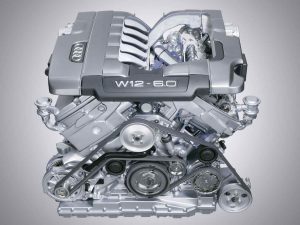
Now you get what used to be available in family cars like the Camry – for the price of what used to buy you a V8 as well as a lot of distance between a mass-market car like the Camry (no offense meant) and a premium car like the A8.
It makes you wonder . . . why?
Especially in view of the essentially nil gas mileage difference between the current A8’s V6/hybrid and the V8 that used to come standard in the A8.
Well, here’s your answer:
The object of this exercise is to lower the “emissions” – as they’re framed – of a gas. You know the one. It isn’t the one that causes the air to brown or the lungs to ache. It is the gas plants breathe – to exhale the oxygen we breathe. This necessary-to-life gas is framed as a “pollutant” by the Left (hat is causing the “climate” to “change” – and if you believe that, I have a safe and effective “vaccine” for you to take.
Nonetheless, the car industry is being forced to produce vehicles that “emit” less C02 and one way to do that is to reduce the size of the engine as much as possible and keep the engine off as often as possible, hence the hybrid set-up (which powers the accessories when the engine is cycled off) and hence the V6 rather than a V8. The latter is always pumping more gasses by volume – having more cylinder volume – and those gasses include C02.
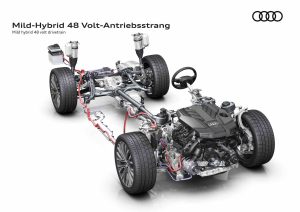
And that’s why you’re paying more for less – including at your Benz and BMW store, too.
On the upside, the A8 has long legs. It can go more than 600 miles on a full tank, which is easily 200 miles farther than the longest-range electric cars and that’s just by the numbers. In real-world driving, EVs almost never deliver on their advertised ranges, which are typically off by 10 percent (more if it’s cold out) and then there’s the having-to-wait at least 20-30 minutes at what they call a “fast” charger to get a partial charge. Which only give you a little range.
A Tesla S is much quicker to 60 than the A8 and its gas-engined competition. But it takes much longer to get places in the Tesla due to all that having to stop – and wait.
An eight speed automatic is standard and so is Audi’s Quattro all-wheel-drive system. A rear-wheel-steering system is also available; it is primarily meant to make it easier to slot the A8 into a curbside parking spot.
Driving a nearly six figure luxury sedan is not the exclusive experience it used to be – chiefly because of what’s no longer under the hood.
The A8 accelerates about as quickly as a V6 Camry – both of which get to 60 in a tick over 5 seconds. Back when the A8 could be powered by a W12, it got to 60 in just over 4 seconds.
To be fair to the new V6-powered A8, it’s actually just about as quick as the V8-powered A8 used to be. But it’s not all about that. The V8 had a quality that is lacking here. A purring smoothness and powerful ease appropriate to the status of a nearly six figure luxury car.
The V6 sounds like less because it is less. And it sounds like it’s working harder – because it is. It is necessary to push the right pedal harder and deeper to get the same performance out of it that the V8 offered up with less effort. There is also the slight but noticeable cycling of the engine off – and back on – at every red light. Before this stop-start thing became a thing, luxury cars like the A8 idled smoothy when the car wasn’t moving – and there was no slight-but-noticeable lag when you wanted to start moving, because the engine was already running.
The A8 and its rivals are still luxury-priced cars but they no longer deliver a driving experience commensurate with what they cost – though that may change as the six cylinder engine becomes the new “exotic” engine.
To be fair – again – to the A8 and its kin – the ride is exceptional, in part because the seats are truly top-shelf. And because there is ample room to stretch out your legs (especially in back; more about that follows below). But Audi – and the other luxury-priced brands – ought to recognize the peril they face in that the non-luxury-priced brands are rapidly catching up. Drive a new Camry and see for yourself. Or drive one of the luxury-priced brand’s mid-tier models; there’s hardly any meaningful difference – other than the price.
In the past, you got that extra something when you paid top dollar for a top-of-the-line model such as an A8 versus say an A6.
Emphasis on six.
You do still get one thing, though, for top-of-the-line dollar.
Even though it’s not as much as what you used to get.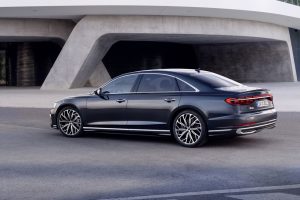
At The Curb
The A8 is still a large car – and that’s a tangible something-you-get for the money.
Large cars are all-but-extinct outside of the luxury car (and top-of-the-line) segment. The largest you can get for less than luxury-car money is something mid-sized – like a Camry or an Accord. But even when you spend luxury car money, you don’t get as much as you used to.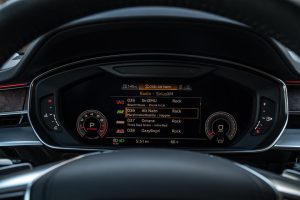
The A8 is 209.5 inches long. Relative to a Camry, that’s longer. But only by slightly more than a foot. Oddly, much of the reason for the abbreviation is the truncated trunk. Big cars used to extend for feet behind the rear axle. Now they’re all pinch-butted and the result is a large car such as the A8 with a small car’s 12.8 cubic foot trunk.
It’s the same as regards the Benz S-Class sedan (which is slightly shorter – at 208.2 feet). It has the same pinch-butt rear and a similarly tiny (relative to the size of the car) 12.9 cubic foot trunk. The BMW 7 is the only one of the three that approaches the length of luxury sedans past – it’s 212.2 inches long – but it also has an oddly small (13.7 cubic foot) trunk.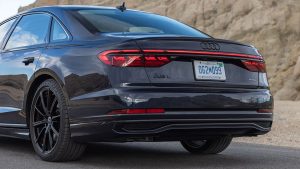
What you do get for the money – in the A8 – is cavernous rearseat legroom: 44.3 inches, which is more legroom than most cars have up front. Including the A8 – which has 41.5 inches of legroom for the driver and front seat passenger. This makes the rearseats the place to be when you go for a ride in this car. Especially when the car is ordered with the Executive package and reclining rear seats. It’s the perfect place to take a nap while on the go.
And this brings up the one other thing that you do get for the money. Or at least, you can order – if you’re willing to spend more money.
The A8 is available with luxury amenities such as massaging seats and heated armrests (front and back) that are not available in lesser-priced cars.
For now.
But how long will it be before they are?
Run-of-the-mill cars now almost all come standard with large LCD displays – and even LCD dashboards – which were luxury-priced car exclusives a decade ago. It is all but certain that many of today’s luxury-priced-car exclusives will become commonplace car features before another ten years pass, if not sooner.
It is all but certain the next A8 won’t even have a V6 – Audi having committed (that is, knuckled under to the pressure applied by the regulatory apparat) to selling electric vehicles exclusively within the next few years.
This could prove to be a problem – and not just for Audi.
When Audis offered W12s – and no one else did – Audis were different. Spectacularly so. What will a battery-powered Audi be that makes it different from a battery-powered Mercedes or BMW?
Or Camry, for that matter?
Duracell vs. EverReady?
The Bottom Line
This may be you last chance to buy an Audi with a V6 – at any price.
. . .
If you like what you’ve found here please consider supporting EPautos.
We depend on you to keep the wheels turning!
Our donate button is here.
If you prefer not to use PayPal, our mailing address is:
EPautos
721 Hummingbird Lane SE
Copper Hill, VA 24079
PS: Get an EPautos magnet or sticker or coaster in return for a $20 or more one-time donation or a $10 or more monthly recurring donation. (Please be sure to tell us you want a magnet or sticker or coaster – and also, provide an address, so we know where to mail the thing!)
If you like items like the Keeeeeeev T shirt pictured below, you can find that and more at the EPautos store!



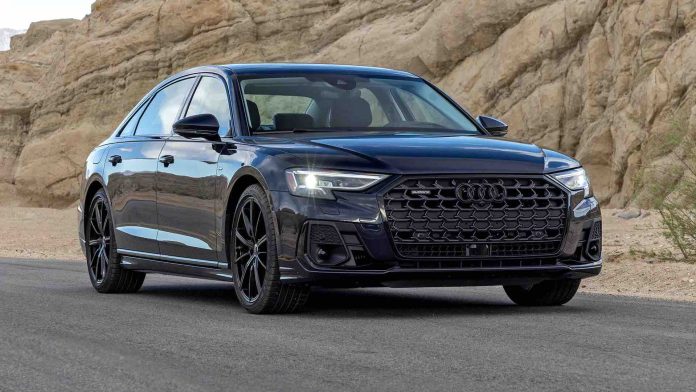

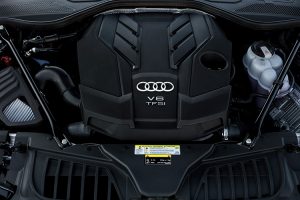
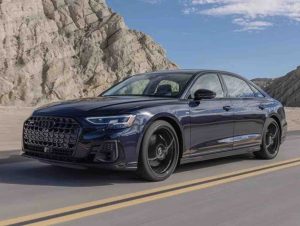
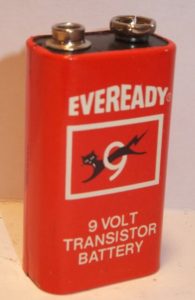







Not a lux car person, but if I was, I don’t find any compelling reason to buy one these days.
Seems like all one would be buying these days is the name. Like you wrote, what’s the difference between a current lux model & a typical family car?
Maybe some nicer appointments and nicer sales/service people.
How long can this trend continue before disaster strikes these companies?
This class of cars has the worst depreciation. In the late 90’s, a girlfriend got a 3 year old BMW 740 for $28,000 from a dealer. That price was likely an inflated one. MSRP was in the high $60K’s.
You can get a V8 in this car if you step up to the S8 model, which starts at 120k – so a 30k jump just to get the V8.
Eric, do you think that another reason for engine downsizing could be the registration fees both in EU and China? These German companies do most of their business in those markets, and the fees to register anything above 3.0L are quite steep. And anything above 4.0L even more so. As an example, in Holland, the fee to register something like a BMW X5 M50i is around 40k euros (yes, 40 thousand!) We still have it pretty good here in the US.
Also, most people don’t care about what’s under the hood anymore. When you ask someone, even someone with wealth – why didn’t you spring for the V8 version of something like the BMW X5, or the 7 series, for instance – they look at you like you’re speaking klingon. So there’s that as well, manufacturers do not properly advertise these engines.
Indeed, Snooty –
It’s tragic. And I’ve had the good (and bad) luck to have begun my run as a car journalist at the beginning of the really good times – and now get to be a witness to the end times.
You are doing God’s work here, so to speak, and I think there is hope. This EV takeover they have been “promising” us is still TBD, in my opinion. Nothing is set.
Another trend that’s quite annoying is putting mild hybrids in performance cars – all of the German ones, even the V8s, now come with a battery and the ASS! And on top of that, the ASS off button is gone, seriously! So your 120k car will shut down at the light just like the cheapest Kia, and you can’t even turn it off. But you are saving 5 bucks a month in gas, yay.
Thank you for the kind words, Snooty!
And – I agree. I cannot fathom spending even $50k on a car that shuts itself off at every red light and then chugs back to life (after a slight but noticeable pause) when you push down on the accelerator.
Note that ASS is not optional – and I know of no one who wanted it.
Yup. Even single suburban housemoms figger out how to disable ASS.
Eric,
I have a dumb question: WHY do luxury car makers no longer equip their flagship sedans with V8s, minimum? Why don’t they offer V12s like they did in the recent past? They’ll be slapped with a “gas guzzler” tax, but who cares? People in position to pay $100K or more for a car aren’t going to quibble over an extra $5K-$10K on top of that; anyone buying a car in that class is buying far more than mere transportation. They’re buying it to make a statement; they’re buying it for status. What screams status and exclusivity more than a V12 under the hood? If money were that important to these buyers, wouldn’t they be buying a less expensive car in the first place? Can you make this make sense, please?
Also, why don’t the luxury car makers continue to offer V8s standard and V12s as options? One, isn’t that what the buyers of such cars WANT? Why not give the buyers what they want? If they’re not going to offer luxury car buyers what they really want (such as big, exclusive engines like V12s), then WHY would those buyers continue paying $100K for a car with just a V6? Why don’t the luxury car makers just sell what the buyers want, and then pass on the gas guzzler tax? Wouldn’t that please their customers more than refusing to even offer what they’ve historically wanted? Again, please make it make sense! I don’t get it…
Hi Mark,
Two reasons why:
First, because of the pressure to comply with the regulatory regime.
Yes, it’s true they could just raise the price of top-of-the-line vehicles, but even at this level there comes a point after which only a few people will pay the price. Besides which, the production of even a relatively small number of V8/V12 powered vehicles will drag down the overall (corporate average) CAFE number, making it more costly to produce (and sell) the mass market stuff. And they realize that – soon – they won’t be allowed to sell anything with an engine, at all.
Second, there is the virtue signaling. It is now the case that affluent buyers want to Preen Green. Their rich Leftie friends will deride them for owning a V8/V12 powered car. It’s like wearing a mink coat nowadays.
Eric,
I’ve often agreed with the OP. I think that, even more than cafe, the regulatory pressure in Europe is really about the volume of CO2; which you mentioned in your article.
Because the machine has decided THE current acceptable Snob Trrrrrrrrrrinkets logo is nought but a styleized T. Any questions ?
Modern luxury cars remind me of Nokia’s Vertu line of phones. In the ’00s, before iOS and Android, Nokia phones were the ones to own. But there was nothing special about them. They had the generic models that made calls and texts. The best thing about them was the Snake game. Then they had the feature phones that ran Symbian OS. They had good cameras, could run apps and play music -all several years before the iPhone.
But then there was the Vertu line. These were no better than the generic phones in function, but they tarted up the cases with stainless steel and leather accents. And jacked up the price. You weren’t getting anything better, just more “luxurious” whatever that meant. Like an over-the-top expensive wristwatch that keeps time worse than a Casio, you paid for the sizzle, not the steak.
Funny thing about Nokia. They had a fantastic phone OS called Maemo that ran on a little Linux handheld tablet called the N800. I stumbled across it after seeing a heavily discounted unit at CompUSA. Here was a full bore Linux PC in my pocket. In 2005. They kept it going for a few years, but decided that they didn’t want to cannibalize sales of the Symbian OS phones so they let it die. The development team quit and stared a company called Jolla, and rebranded Maemo to Sailfish OS. It is still a fantastic OS but cannot be imported to the US due to patent restrictions, and your wireless carrier might look askance at your phone if you try to activate it. I believe it is the only OS permitted to be run on Russian government phones, although Jolla says they no longer do business in RU.
Imagine if a group of engineers got their project (like plug in hybrids) shut down by management and decided to go build their own cars…
Its now Mandatory to provide cell carrier name to deal online with some US gubmint agencies.
Who or what owns and runs gubmint